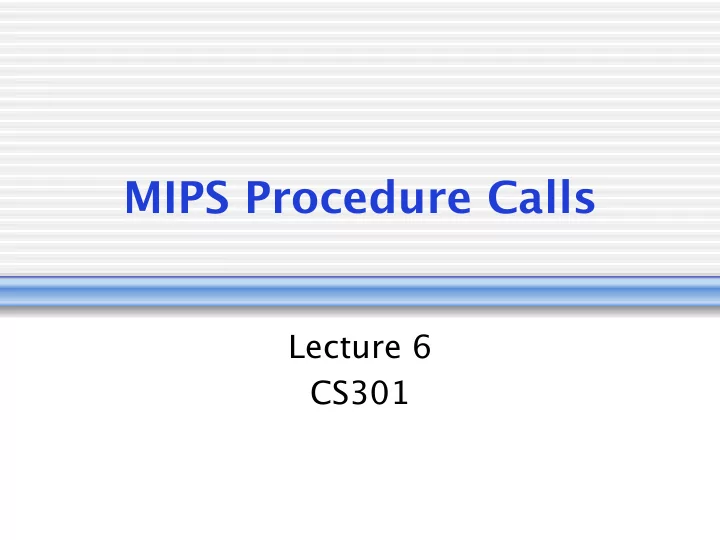

MIPS Procedure Calls Lecture 6 CS301
Function Call Steps • Place parameters in accessible location • Transfer control to function • Acquire storage for procedure variables • Perform calculations in function • Place result in place accessible to caller • Return control to caller
MIPS Function Calls • Parameters � $a0-$a3 • Return values � $v0-$v1 • Where to return control to � $ra
MIPS Function Calls • Transfer control to function � jal label � Jumps to label’s instruction � Stores return address in $ra (PC+4) • Return control to caller � jr $ra
Other Register Conventions • Caller-saved registers � $t0-$t9, $a0-$a3 � No preservation assumed • Callee-saved registers � $s0-$s7 � If you use these, you must restore values before returning • Stack pointer � $sp � Points to last location on stack
Examples • Suppose $s0 = a, $s1 = b, $s2 = c, $s3 = d • Write MIPS instructions for the following code (assuming code for ABS already written): b = ABS(d)
Address Space 0x7fffffff • Each process has an address Stack space • The address space is divided into segments: � Text � Instructions � Initialized Data � Globals � Uninitialized Data or Heap Uninitialized Data � new allocates space here (Heap) � Stack Initialized Data � local variables are given space here 0x10010000 Text 0x400000 Reserved 0x0
MIPS Function Calls: Local Storage high addresses • Stack sp+i sp � LIFO � $sp sp-i • Non-volatile registers low addresses � Push onto stack at function call � Restore to registers before function return • Spill local register values onto stack if not enough registers for function operation
Procedure Frame/ Activation Record high addresses fp sp arg 5, 6, … fp saved reg local var sp low addresses • Segment of stack that contains procedure’s saved registers and local variables • Frame pointer ($fp) points to first word of procedure frame
Procedure Frame/ Activation Record high addresses fp fp a.k.a. base sp pointer (bp). arg 5, 6, … fp Register 30 (s8) saved reg in MIPS. local var sp low addresses • Segment of stack that contains procedure’s saved registers and local variables • Frame pointer ($fp) points to first word of procedure frame (a.k.a. stack frame)
Procedure Frame/ Activation Record high addresses fp sp caller arg 5, 6, … fp saved reg callee local var sp low addresses • Segment of stack that contains procedure’s saved registers and local variables • Frame pointer ($fp) points to first word of procedure frame (sort of)
Function Call Example int CalculateTriangleArea(int b, int h) { int area = b * h; area /= 2; return area; } int main() { int b = 4; int h = 10; int val = CalculateTriangleArea(b, h); }
About the code that follows... • It was generated by a compiler, so it’s not like code one would write • Some assemblers use $s8 to store the frame pointer (this code does) • $gp (the “global pointer” register), when used, points to a pool of global data that can be commonly referenced by all functions. � Convention dictates you should always store it when you code a function (who knows why) � 13
Caller Function 12: int b = 4; [ 12] 0x100010c0: 24 02 00 04 li v0,4 [ 12] 0x100010c4: af c2 00 10 sw v0,16(s8) 13: int h = 10; [ 13] 0x100010c8: 24 02 00 0a li v0,10 [ 13] 0x100010cc: af c2 00 14 sw v0,20(s8) 14: int val = CalculateTriangleArea(b, h); [ 14] 0x100010d0: 8f c4 00 10 lw a0,16(s8) [ 14] 0x100010d4: 8f c5 00 14 lw a1,20(s8) [ 14] 0x100010d8: 8f 99 80 68 lw t9,-32664(gp) [ 14] 0x100010dc: 03 20 f8 09 jalr t9 [ 14] 0x100010e0: 00 00 00 00 nop [ 14] 0x100010e4: af c2 00 18 sw v0,24(s8)
Example int pow(int base, int exponent) // Assumes base and exponent are both >= 0 { int result = 1; for(int i = 0; i < exponent; i++){ result *= base; } return result; }
Solution
Recursive Functions int fact(int n) { if(n < 1) return 1; else return (n*fact(n-1)); }
Recursive Functions int fact(int n) { if(n < 1) return 1; else return (n*fact(n-1)); } • Acquire storage for procedure variables • Perform calculations in function • Place result in place accessible to caller • Return control to caller
Your Turn int pow(int base, int exponent) // Assumes base and exponent are both >= 0 { int result = 1; if(exponent == 0) return result; else{ result = base * pow(base, exponent-1); } return result; }
System Calls • Used to interact with operating system • For our purposes, use for I/O � Print output to console • syscall � Place arguments to syscall in registers � Put number specifying which syscall into $v0 � It’s like a function call with respect to register conventions print_int 1 $a0=integer print_string 4 $a0=string read_int 5 result in $v0 read_string 8 $a0=bu fg er, $a1=length
Discussion Given the following function header, int foo(int a, int b); what will be on the stack before any of the calculations in foo are performed? Assume foo() calls some other function.
Discussion What will be on the stack on a call to int foo(int a, int b, int c, int d, int e, int f)?
� 25
� 26
Recommend
More recommend